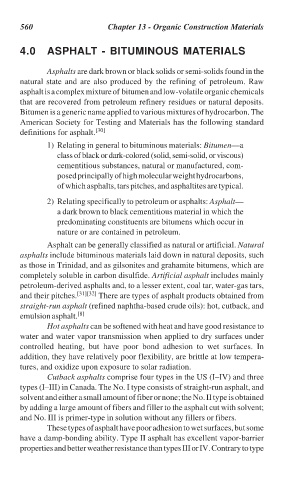Page 593 - Handbook of Thermal Analysis of Construction Materials
P. 593
560 Chapter 13 - Organic Construction Materials
4.0 ASPHALT - BITUMINOUS MATERIALS
Asphalts are dark brown or black solids or semi-solids found in the
natural state and are also produced by the refining of petroleum. Raw
asphalt is a complex mixture of bitumen and low-volatile organic chemicals
that are recovered from petroleum refinery residues or natural deposits.
Bitumen is a generic name applied to various mixtures of hydrocarbon. The
American Society for Testing and Materials has the following standard
definitions for asphalt. [30]
1) Relating in general to bituminous materials: Bitumen—a
class of black or dark-colored (solid, semi-solid, or viscous)
cementitious substances, natural or manufactured, com-
posed principally of high molecular weight hydrocarbons,
of which asphalts, tars pitches, and asphaltites are typical.
2) Relating specifically to petroleum or asphalts: Asphalt—
a dark brown to black cementitious material in which the
predominating constituents are bitumens which occur in
nature or are contained in petroleum.
Asphalt can be generally classified as natural or artificial. Natural
asphalts include bituminous materials laid down in natural deposits, such
as those in Trinidad, and as gilsonites and grahamite bitumens, which are
completely soluble in carbon disulfide. Artificial asphalt includes mainly
petroleum-derived asphalts and, to a lesser extent, coal tar, water-gas tars,
and their pitches. [31][32] There are types of asphalt products obtained from
straight-run asphalt (refined naphtha-based crude oils): hot, cutback, and
emulsion asphalt. [8]
Hot asphalts can be softened with heat and have good resistance to
water and water vapor transmission when applied to dry surfaces under
controlled heating, but have poor bond adhesion to wet surfaces. In
addition, they have relatively poor flexibility, are brittle at low tempera-
tures, and oxidize upon exposure to solar radiation.
Cutback asphalts comprise four types in the US (I–IV) and three
types (I–III) in Canada. The No. I type consists of straight-run asphalt, and
solvent and either a small amount of fiber or none; the No. II type is obtained
by adding a large amount of fibers and filler to the asphalt cut with solvent;
and No. III is primer-type in solution without any fillers or fibers.
These types of asphalt have poor adhesion to wet surfaces, but some
have a damp-bonding ability. Type II asphalt has excellent vapor-barrier
properties and better weather resistance than types III or IV. Contrary to type

